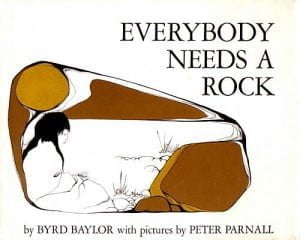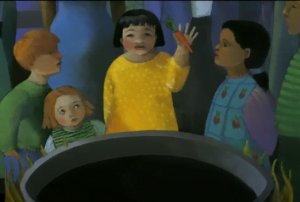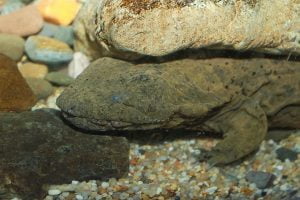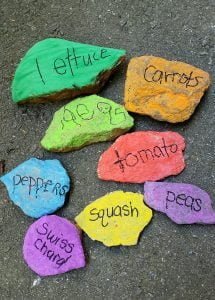This week’s theme is rocks and minerals. Our “Growing Minds Day by Day” educational resource lists are designed for families and educators.
We hope these resources will provide you with inspiration. If you don’t find what you’re looking for here, be sure to check out our Lesson Plans page.
 Book:
Book:
Today’s book recommendation is Everybody Needs a Rock, written by Byrd Baylor and illustrated by Peter Parnall. Want to be friends with one of the oldest things on earth? Many rocks have existed for millions of years. Some formed in the ocean, deep underground, or on the surface of the earth as volcanoes cooled! Read this book to learn the ten rules for finding a special rock of your own. Watch a read-aloud of this book on YouTube.
Find more books
Looking for more children’s books? Visit the Growing Minds’ farm to school literature database to browse our collection of recommended books. Type “rocks” into the search bar to find books that align with this week’s theme.
 Local Food Recipe:
Local Food Recipe:
Before you prepare today’s recipe, watch this animated short of the classic fable, Stone Soup, retold by Heather Forest. In this story, two hungry travelers visit a village hoping to find a bite to eat, but are turned away at house after house. Using a little ingenuity, they eventually convince the villagers to each contribute one ingredient to a big pot of stone soup. The story teaches us that each person’s small contribution can ultimately lead to a big collective impact. If you want to take the lesson further, the publisher, August House, has developed corresponding lesson plans that are adapted for children in Pre-K through second grade.
You can find countless variations on stone soup online, but at its heart, it’s a hearty vegetable soup made with whatever ingredients you have on hand. Grains (barley or rice), beans, or meat can also be added to suit your taste. Find both a classic and a vegetarian stone soup recipe here, or use this recipe from the Growing Minds website for cabbage soup as a starting point and adapt based on what ingredients you have available. Don’t forget to add a nice clean stone to the pot, and to let your kids help prepare this special soup!
 Educational Resources:
Educational Resources:
Exploring River Rock Habitats: Rocks found in rivers and streams provide important habitat for aquatic creatures, including insects, fish, and the threatened hellbender, a giant salamander that calls the streams of our Appalachian Mountains home. When people move river rocks in order to build cairns (stacks of balanced rocks), walls, or dams, they can accidentally disturb these animals’ homes, destroy their nests, or even crush them. The good news is, you can help protect our streams and the unique animals who live in them by leaving river rocks in place. Watch this short video, The Last Dragons: Protecting Appalachia’s Hellbenders to learn more about this amazing and threatened species. Visit the Friends of the Smokies website to learn more about how you can protect our mountain ecosystems.
Minerals in the Garden: We all know that plants need sunlight and water to grow, but did you know that plants also need 13 essential minerals in order to fully develop? Many of the minerals found in the soil are created through the weathering and breakdown of larger rocks. Minerals can also be added to garden soil through the application of fertilizer. Learn more about basic plant nutrition from Organic Growers School.
The geology of North Carolina: Visit the NC Department of Environmental Quality’s Geology Matters page to learn interesting facts about how rocks and minerals are used in our everyday life, plus explore the geology of North Carolina’s state parks.
More on Rocks and Minerals: The National Park Service has compiled a great list of educational resources, videos, and more that will help you and your children explore geology, rocks and minerals.
 Activity:
Activity:
After reading the story Everybody Needs a Rock, find your own rock by following the rules from the book:
- Go to a mountain to find your rock. If you can’t, any place will do.
- Don’t let anyone talk to you while you are choosing your rock.
- Bend over, way over. You have to be able to look a rock in the eye.
- Don’t get a rock that is too big. A rock as big as an apple is too big.
- Don’t get a rock that is too small.
- The rock should feel good in your hand.
- Look for the perfect color. Dip it in water to see its real colors.
- The shape of your rock is up to you. It should look good all by itself in the bathtub.
- Sniff your rock, find the one that suits you best.
- Don’t ask anybody to help you choose. You have to make up your own mind. You’ll know.
Once you have selected your rock, describe your rock in the following ways so that someone else can get to know it, too.
- Draw a picture of your rock. Include colors.
- Describe your rock with words. Some words that might apply: rough, smooth, jagged, heavy, layered, spotted, gritty, or round.
- Weigh your rock.
- Measure your rock.
- Smell or taste your rock and include a description.
 Using rocks in the garden:
Using rocks in the garden:
Garden Signs: Using our Garden Signs lesson plan, children will practice identifying plants in the garden. Rocks that are painted or decorated with permanent markers make colorful, durable garden signs, but if you don’t have rocks available, our lesson plan offers several alternative ideas. First, take inventory of plants that you need identification signs for. Consider labeling the plants in your herb, vegetable, or flower garden. These could be plants that you are already growing or plan on growing in the garden. Once you know how many signs you need, collect the materials you’ll use to create your signs. Take this activity further by labeling plants in multiple languages so that your family can expand its vocabulary.
Make a Rock Garden: Children love to dig in the soil, stack and sort rocks, and make mud pies. In your vegetable garden or in your yard, create a place for your child to explore, dig, and create with natural objects. Follow these simple directions to get started:
- Take the grass or sod off of a patch of earth, provide some digging tools, and watch your child explore.
- Go on a rock collecting walk with your child and bring the rocks back to their soil garden.
- Give your child the freedom to play and create with rocks, bark, sticks, and mud. Here are a few ideas to get them started: Can your child use the rocks as a tool to dig? What kind of sculptures can they make? How many can they stack? Can they make a path, a cave, or a little house with the rocks? Ask your child to sort the rocks into big and small piles, or by color. Bring water into the rock garden and let your child wet the rocks. What happens when the rocks are wet?
Rock Spiral Herb Garden: Follow the steps in this lesson plan created by kidsgardening.org to create a beautiful Rock Spiral Herb Garden in your yard. In addition to building a unique structure with rocks, your children will explore why different plants have different sunlight and water requirements. You can also use rocks to build beautiful borders around your garden beds.
This Week in the Garden: Check out the Growing Minds This Week in the Garden (TWIG) newsletter for the first week in June for more garden activities and a seasonal recipe. Growing Minds’ “Get Local” product for the month of June is summer squash.
—
That’s it for this week. Next week’s Growing Minds Day by Day theme will be fireflies! Be sure to check back next week for new resources. Click here to access Day by Day resources from past weeks.


 Book:
Book: Local Food Recipe:
Local Food Recipe: Educational Resources:
Educational Resources: Activity:
Activity: Using rocks in the garden:
Using rocks in the garden: